 |
|
Plan from the Start to Pick the Best Oriental Rugby KRISTEN ARMSTRONG, Staff Writer
|
|
| Looking for a beautiful piece
of art for your home, but want something besides paintings and
sculpture? You might want to look into investing in an Oriental rug. “Rugs are a work of art. They're not just floor coverings” said Paul Aliloo of Aliloo Oriental Rugs in a recent interview. “Antique [rugs] are the most underpriced works of art in the world.” Unlike traditional works of art, however, Oriental rugs should not be treated as accent pieces. Rather, they should be used as a unifying element of a room's design, and when decorating, the “best thing to do is to start with the rug,” Aliloo said. “The rug is going to dominate the room no matter what, because of the size,” he said. “It's always easier to pick colors for upholstery and draperies from the rug.” How do you pick the right rug for your home? First, decide in which room the rug will be placed and determine the amount of foot-traffic for that space. “You cannot use a 19th century rug in a high-traffic area,” Aliloo said. “But semi-antiques usually keep up with any amount of traffic.” (Antique rugs are those made at least 70 years ago, and semi-antiques generally are 40 to 70 years old.) Next, figure out the desired mood of the room. Formal rugs, such as Aubussons, Esphahans and some Tabrizes, use smaller, more intricate designs, with as many as 500 to 600 knots per inch. The patterns often are outlined in silk. For a more contemporary look, buyers should look at less formal and less detailed rug patterns such as Sultanabads and Serapis. The last factor one should consider before buying an Oriental rug is budget. Depending on size, weave, age and origin, rugs can range in price from $5,000 to $200,000. Although an Oriental rug is not cheap, they “last forever,” Aliloo said and “they're a piece of history that can stay in a family for generations.” But getting your hands on an authentic antique Oriental rug isn't always easy. “There was a time when I would walk in a bazaar [in Iran] and I'd see stacks of rugs,” Aliloo said. “Now, [the few that are left] are rolled up and hidden in a corner.” Despite the challenge of finding quality antique rugs, Aliloo's showroom in Middleburg boasts between 1,000 and 1,200 different rugs. He has numerous 19th-century Herizes Sultanabads and Serapis, a selection of 18th-century rugs and even a 16th century tapestry. Aliloo also offers services such as restoration, reweaving, cleaning and mounting of tapestries. But don't come asking Aliloo to fix what looks like inconsistent color in a rug. The use of different natural dyes creates “abrash,” subtle shading differences, and are part of the beauty of a true antique Oriental rug. “These are one of a kind,” he said. “They are not perfect because they are art of hands, made by man.” For more information on Oriental rugs, contact Paul Aliloo at (540) 687-3048. |
 |